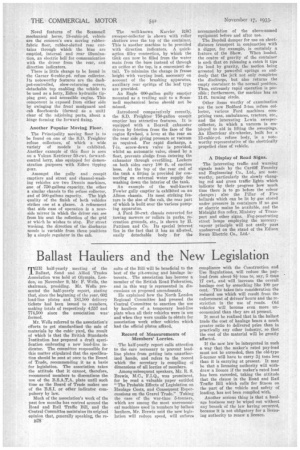Ballast Hauliers and the New Legislation
Page 42

If you've noticed an error in this article please click here to report it so we can fix it.
?VIM half-yearly meeting of the Ballast, Sand and Allied Trades Association was held at Olympia, London, on 'November 9, Mr: F. Wells, the chairman, presiding. Mr. Wells presented the half-yearly report, stating that, since the beginning of the year. 602 load-line plates and 183,500 delivery tickets had been issued to members, making totals of respectively 4,557 and 774,500 since the association was' formed.
Mr. Wells referred to the association's efforts to get standardized the sale of materials by the cubic yard, the result of which is that the British Standards Institution has prepared a draft specification embracing a new load-line indicator. The committee responsible for this matter stipulated that the specification should be sent at once to the Board of Trade, recommending it as a basis for legislation. The association takes the attitude that it cannot, therefore, recommend members to discontinue the use of the B.S.A.T.A. plate until such time as the Board of Trade makes use of the B.S.I. or other indicator compulsory by law.
Much of the association's work of the past few months has centred around the Road and Rail Traffic Bill, and the Central Committee maintains its original opinion that, generally speaking, the re
n28
sults of the ilill will be beneficial to the best of the pit-owning and haulage interests. The association has become a member of the British Road Federation, and in this way is represented in discussions on proposed amendments.
Ile explained how the North London Regional Committee had pressed the Central Committee to sanction the use by hauliers of a temporary load-line plate when all their vehicles were in use and when they were unable to obtain for association work other vehicles which had the official plates affixed.
Record of Measurements of Members' Lorries.
. The half-yearly report calls attention to the cure necessary to prevent loadline plates from getting into unauthorized hands, and refers to the record which the secretary is compiling of dimensions of all lorries of members.
Among subsequent speakers, Mr. R. S. Brawls, m.o., P.I.Q., was prominent, for he read a valuable paper entitled "The Probable Effects of Legislation on Haulage Costs, and Consequent Repercussions on the Gravel Trade." Taking the case of the war-time 5-tonners, which are among the most uneconomical machines used in numbers by ballast hauliers, Mr. Brewis said the new legislation will reduce speed, will enforce compliance with the Construction and Use Regulations, will reduce the payload from about 8 tons to, say, 5 tbus 17 cwt, and will increase the overall haulage cost by something like 100 per Cent. This takes into consideration the reduced use which will result from the enforcement of drivers' hours and the restriction in the use of roads. Old vehicles will become even more uneconomical than they are at present.
It mast be realized that in the ballast trade the cost of haulage bears a much greater ratio to delivered price than in practically any other industry, so that the cost of the material will be greatly affected.
If the new law be interpreted in such a way that the maker's rated pay-load must not be exceeded, then the old-type 5-tonner will have to carry 3i tons less than it is carrying at present. It may be that a licensing authority will withdraw a licence if the maker's rated load has been exceeded, taking the attitude that the clause in the Road and Rail Traffic Bill which calls for fitness on the part of the vehicle and safety of loading, has not been complied with.
Another serious thing is that a haulage business may be wiped out without any breach of the law baring occurred, because it is not obligatory for a licensing authority to renew a licence.




























































































